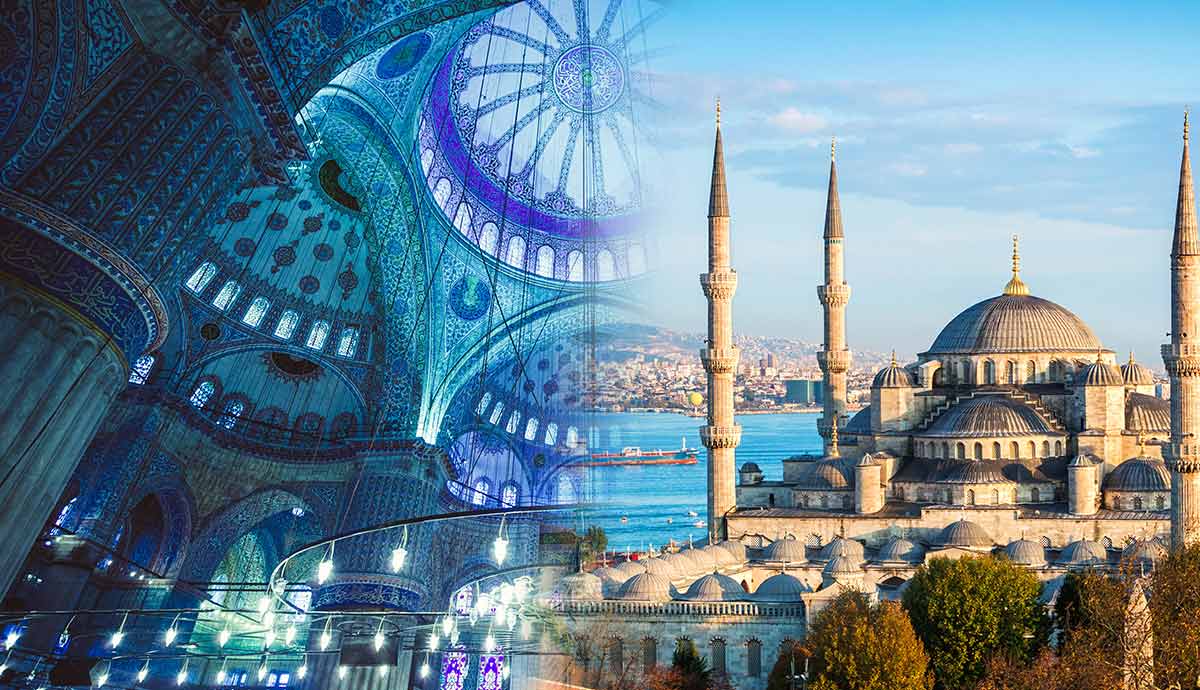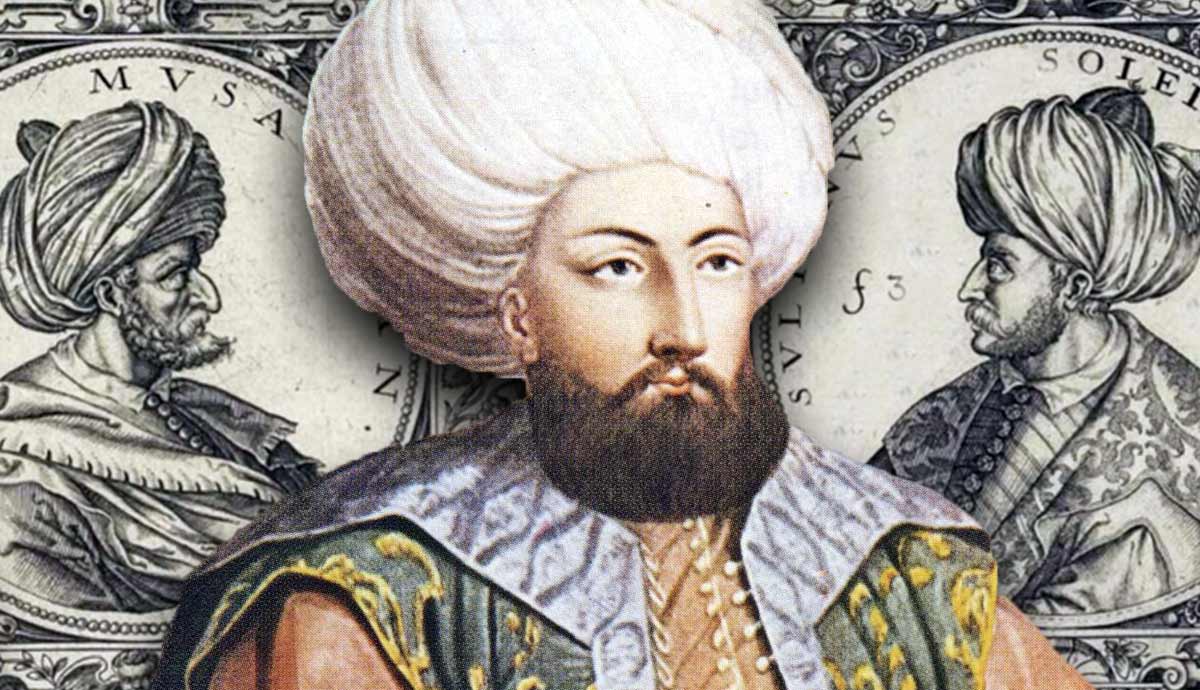
In its early years, the Ottoman Empire was inspired by Persio-Islamic and Byzantine culture. This affected the style of Ottoman architecture, and Mosques, madrasas, hospitals, bazaars, and palaces reflected this rich cultural blend. Learn about ten architectural marvels from the Ottoman Empire below.
1. Ulu Camii: The Grand Mosque of Bursa

Ottoman Sultan Bayezid I (d. 1402) commissioned architect Ali Neccar to build the massive Ulu Camii (Grand Mosque) complex between 1396 and 1399. With a surface area of 3,165.5 square meters (34,073.1 square feet), the complex accommodates around 5,000 people. The courtyard contains a sadirvan, a fountain over a water basin in which Muslims perform the ablution before prayer.
The mosque is significant because it represents a shift in Turkish architectural style. In contrast to beylik (principality) and Seljuk Period architecture, the Ulu Camii incorporated more Islamo-Persian structures and designs.
During its 600 years of existence, the mosque has seen several catastrophic events. In 1402, the Turco-Mongol conqueror—and Bayezid’s greatest rival—Tamerlane attempted to burn the mosque down. In 1412, the mosque was yet again targeted by Mehmed Bey, ruler of the Karamanid principality which had put Bursa under siege.
Earthquakes throughout the centuries also damaged the exterior and interior of the building, leading to a melange between earlier Ottoman and later Baroque-style paintings and patterns. Still, Islamic calligraphy and geometric motifs are dominant inside the mosque.
2. Rumeli Fortress: The “Throat Cutter”

By the mid-15th century, the imperial Byzantine capital Constantinople had seen its fair share of failed sieges and conquests. The Bosphorus Strait, the waterway connecting the Black Sea to the Sea of Marmara, had protected the city from assailants and conquerors. That was until the arrival of the ambitious Ottoman Sultan Mehmed “the Conqueror” who conquered the city in 1453.
Like his great-grandfather Bayezid I who had commissioned the Anadolu Fortress, Mehmed understood that a strategic fortification was necessary. Construction of the Boğazkesen or “strait-cutter” was started in 1451. A chilling reminder of its role in the conquest, Boğazkesen’s literal meaning was “throat cutter,” from the Turkish boğaz, “throat,” and kesen, “cutter.”
Not only did this fortress station janissaries and artillery in preparation for the conquest but it controlled access to the waterway and entry to Constantinople; Venetian ships were forced to pay a toll when passing, and when they refused, were sunk to the bottom of the Bosphorus. Mehmed knew that with this new fortress, he could also prevent the Venetian and Genoese allies of the Byzantines from sending reinforcements from their colonies in the Black Sea.
The fortress, composed of three main towers and 13 smaller watchtowers, was built on a hilltop opposite the Anadolu Fortress. Houses for janissary troops and a small mosque were also built in the mid 15th-century, however, they have not survived to this day. In later centuries, it was called the Rumeli Hisari or “Fortress on the Romans’ land,” a nod to the Medieval name for Byzantine territories.
3. Topkapi Palace: Imperial Residence of the Ottoman Sultans

Following Mehmed II’s conquest of Constantinople in 1453, the city became the new capital of the Ottoman Empire. Six years later, in 1459, he ordered the construction of a grand palace that would be home to the Sultan and a meeting place for imperial ministers until 1853.
The Topkapi (“Canon Gate”) Palace is a grand complex, consisting of kitchens, schools, storerooms, halls, treasuries, libraries, mosques, and more. Moving through several massive courtyards, one can reach the harem (women’s quarters), divan (council meeting chamber), and many pavilions and kiosks.
Throughout the centuries, various Sultans added their touches to the complex. During the reign of Sultan Süleyman “the Magnificent” (r. 1520-1566), the harem was built, and the Sultan’s family was moved into the palace. Sultan Ibrahim I “the Mad” (d. 1648) had a Sünnet Odasi (“circumcision room”) added to accommodate young princes after their traditional circumcision. In 1840, Sultan Abdul Mecid I had a kiosk built in European architectural style.
4. Istanbul University: The City’s Oldest-Running University

Also built after the conquest of Constantinople, Istanbul University is the oldest-running academic institute in Turkey. It was initially founded as a medrese, a traditional institute of Islamic theology that also taught law, medicine, mathematics, and sciences like astronomy and cartography. While it functioned effectively in this way in the Medieval and Early Modern periods, by the 18th century the institute could not keep up with European advances in art and science.
In the 19th century, the declining Ottoman Empire instituted a series of reforms that were aimed at modernizing and liberalizing Turkey in the image of European nations. Changes to Istanbul University were part of these reforms; the school became a type of technical university in 1863.
Like the Topkapi Palace, the architecture of the university was developed and refined over several centuries. Its final form is a melange of different styles: there are Ottoman shapes, like domed entrances, long rectangular structures and windows in 19th-century European style, and many modern buildings.
5. Koza Han: A Story of Cocoons and Silk

The Koza (“Cocoon”) Han is a caravanserai located in Bursa, a historic city in Northwestern Turkey. The building was commissioned in 1491 by Sultan Bayezid II. Bayezid gave immense importance to the silk trade which happened to be a critical part of the Ottoman economy. As a city on the famous Silk Road, Bursa was not only a producer of fine textiles but was a hub for international merchants, traders, and craftsmen.
The Koza Han was built in a rectangular formation, with a two-story gallery encircling a large courtyard. A total of 104 rooms graced the caravanserai, used by merchants as lodgings, offices, and workshops. The Medici, a famous Italian political dynasty, even had a commercial agent and office at the Han.
Decorated in the traditional eastern style, Koza Han has geometric patterns and domed entranceways reminiscent of other Silk Road caravanserais. Today, it is used as a bazaar, with a leisurely area where visitors can enjoy the historic view with a cup of Turkish coffee!
6. Süleymaniye Mosque : A Sultan’s Legacy

The Süleymaniye, named after its patron Sultan Süleyman “the Magnificent,” is one of the largest mosque structures in Turkey. Desiring a mosque that would rival the Hagia Sophia, Süleyman had Sinan, one of the most prolific architects in history, build this grand structure in 1557. Standing at 59 meters (194 feet) long and 58 meters (190 feet) wide, the structure consists of a total of 15 domes, of which the highest and most central is 53 meters (174 feet) tall.
Like most Ottoman mosques, the building was part of a complex that housed schools, soup kitchens for the poor, bathhouses, and medical centers. It also houses the tombs of Suleyman and his beloved wife Hürrem.
In its current form, the Süleymaniye is made up of both original and restored structures. A fire in 1660 and an earthquake in 1766 caused damage to the original building, which was restored in more contemporary styles. Due to its location in earthquake-prone Istanbul, the mosque is undergoing further restoration.
7. Hürrem Sultan Hamam: A Bathhouse Fit for a Queen

Hamams, commonly known as “Turkish Baths,” were an important part of 16th-century Ottoman culture. They were not simply places where one would bathe or relax. The hamam also played the role of a social institute where people discussed life, marriage, politics, and religion.
Royal and elite figures often commissioned the building of a hamam as a sort of public service. In 1556, Hürrem Sultan, the powerful wife of Sultan Süleyman I and mother of Sultan Selim II, had this bathhouse constructed in Istanbul as a gesture of her charitability.
The building is split into separate sections for men and women. Each of these sections contains a dressing room, cooling room, and heating room decorated in beautiful white marble. The bathhouse was re-opened in 2007 after almost a century of disuse. It continues to attract foreign tourists looking to experience an authentic Ottoman spa treatment.
8. Stari Most: A Bridge in the Balkans

One of the most recognizable structures in the world, Mostar Bridge (Stari Most) has an amazing tale to tell. Ordered by Sultan Süleyman in 1557, the bridge was built by Hayreddin—a pupil of the architect Sinan—in the city of Mostar, present-day Bosnia and Herzegovina. According to legend, the architect Hayreddin, believing that the massive structure would collapse, prepared for his funeral on the day that the scaffolding was to be removed.
Luckily for him, the ambitious project was a success! The bridge’s total height is 29 meters (95 feet) and was—at the time of its construction—the widest single-arch bridge in the world. The bridge was an important addition to the city, which although growing in economic importance, still sported a wooden suspension bridge that people feared to use.
Unfortunately, on November 9, 1993, the bridge was deliberately targeted by the Croat Defence Council commander and convicted war criminal Slobodan Praljak. After the destruction of this treasured historical monument, a temporary structure was put up in its place. In 1998, UNESCO assembled a team of experts to design and reconstruct Stari Most as close to the original structure as possible. The reconstructed bridge was completed in 2004 and has become a major tourist attraction since.
9. The Blue Mosque: The Icon of Istanbul

Arguably the most iconic piece of Ottoman architecture, this UNESCO World Heritage Site attracts 4.5 million tourists per year. Known as the Blue Mosque because of the beautiful blue Iznik tiles that decorate its interior, the Sultan Ahmet Mosque—as it is known in Turkey—was constructed between the years 1609 and 1617.
Sultan Ahmed I (d. 1617) ordered architect Sedefkar Mehmed Aga to create a structure that would invite the grace of God after his geopolitical defeat by the Habsburg Empire. The mosque was built near the Hagia Sophia and Topkapi Palace and required the demolition of several palaces inhabited by Ottoman viziers and ministers.
Naturally, this caused controversy among the populace, which was exacerbated when the ulema (religious scholars) banned people from praying at the mosque because it was built with money from the treasury rather than from the spoils of war.
According to architectural historians, the Blue Mosque married elements of Byzantine architecture, such as large central domes, with Islamic features, such as courtyards, minarets, and stained glass windows. However, the mosque differs from earlier Ottoman structures in several ways; it has a more extravagant façade, a higher number of minarets and cascading domes which create a softer visual element.
10. Ishak Pasha Palace: An Eastern Gem

Located in the city of Agri, Eastern Turkey, the Ishak Pasha Palace is a unique example of a mixture of Anatolian, Iranian, and Byzantine architecture. The palace was commissioned in 1685 by Çolak Abdi Pasha, a member of the aristocratic Çildiroğullari family. Inhabited by generations of the family, it was largely abandoned in 1840 after an earthquake caused extensive damage to the structure.
The Eastern façade of the building carries many medieval Islamic motifs and designs; three-dimensional muqarnas carvings that are seen in Abbasid, Persian, and Seljuk architecture grace the entryways of Ishak Pasha. Walls and doors are carved with floral and animal motifs, not unlike those seen in Byzantine ruins.
Construction of the palace took almost a century, ending around 1780. This may explain why gothic arches, Baroque-style carved columns, and checkered stone motifs are also present in certain areas of the palace.
Despite its semi-ruined status, the Ishak Pasa Palace is one of the only surviving Ottoman-era aristocratic palaces, making it an attractive destination for both local and foreign tourists.







